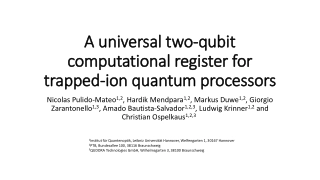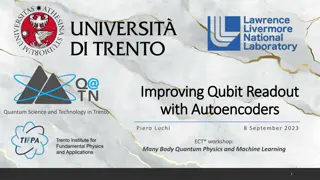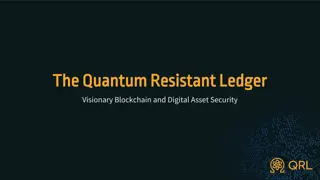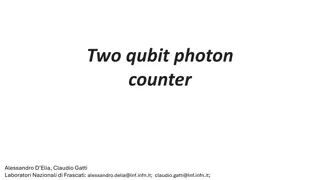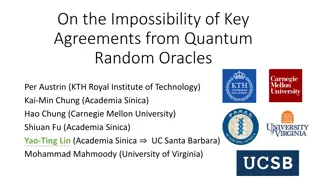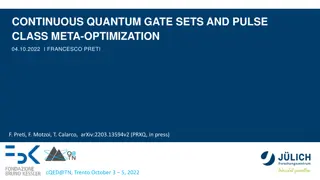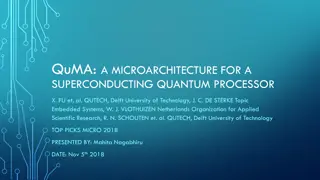QuCloud: A New Qubit Mapping Mechanism for Multi-programming Quantum Computing
Multi-programming in quantum computing cloud services aims to enhance throughput and resource utilization while addressing challenges related to fidelity degradation and contention between concurrent quantum programs. This research introduces innovative solutions such as Community Detection Assisted Partition (CDAP) and X-SWAP for improved compilation efficiency and resource allocation, resulting in significant improvements in fidelity and compilation overheads reduction.
Download Presentation

Please find below an Image/Link to download the presentation.
The content on the website is provided AS IS for your information and personal use only. It may not be sold, licensed, or shared on other websites without obtaining consent from the author.If you encounter any issues during the download, it is possible that the publisher has removed the file from their server.
You are allowed to download the files provided on this website for personal or commercial use, subject to the condition that they are used lawfully. All files are the property of their respective owners.
The content on the website is provided AS IS for your information and personal use only. It may not be sold, licensed, or shared on other websites without obtaining consent from the author.
E N D
Presentation Transcript
QuCloud: A New Qubit Mapping Mechanism for Multi-programming Quantum Computing in Cloud Environment Lei Liu, Xinglei Dou (Speaker) Sys-Inventor Lab, SKLCA, ICT, CAS IEEE HPCA-2021 (Session 2B)
Executive Summary Multi-programming in quantum computing cloud services has been proposed to improve the throughput and resource utilization Challenge: Multi-programming leads to degradation in fidelity and contention between concurrent quantum programs Goal: To improve throughput and resource utilization while ensuring fidelity Solutions: Community Detection Assisted Partition (CDAP): Locate the robust resources for initial mapping X-SWAP: Enable inter-program SWAPs for reducing compilation overheads Compilation task scheduler: Fairness, trade-off between throughput and fidelity Results: 9.7% improvement in fidelity; 11.6% reduction in compilation overheads
Outline Introduction Motivation Designs Evaluation Conclusion
Quantum Computing Quantum Computing (QC) can solve conventionally hard problems Chemistry simulation [Kandala et al., Nature 2017] Database search [Grover, STOC 1996] Machine learning [Biamonte et al., Nature 2017] Quantum computers are accessible via cloud Chip error rates Probability (%) Chip topology Problem Quantum Cloud Service Quantum program Local Compiler 00 01 10 11 Output Compiled program Result
Why Multi-programming is Needed? Contention in accessing a quantum computer Users QC Quantum computer Task queue cloud service Resource under-utilization Allocated qubits Idle qubits Q0 Q1 Q2 Q3 Q4 Q5 Q6 Q7 Q8 Q9 Only small circuits can be executed reliably Q10 Q11 Q12 Q13 Q14 Q15 Q16 Q17 Q18 Q19 IBM, 50 qubits Q20 Q21 Q22 Q23 Q24 Q25 Q26 Q27 Q28 Q29 Q30 Q31 Q32 Q33 Q34 Q35 Q36 Q37 Q38 Q39 Q40 Q41 Q42 Q43 Q44 Q45 Q46 Q47 Q48 Q49 Google, 72 qubits NISQ computers with tens of physical qubits Qubits are underutilized
One Step to explore Quantum OS - QuOS Noise Intermediate Scale Quantum (NISQ) era Quantum Error Correction (QEC) is too expensive to be implemented Noise-aware quantum compilers Algorithms (Grover search, Shor factoring, ) High-level languages (QASM, Scaffold, ) Quantum Software Stack (Compiler, OS) (initial mapping, mapping transition) Our work Quantum architecture (qubits, gates, ) Quantum Error Correction & Control pulses (surface code,...) Physical implementation (superconducting, ion-trap, photonic, ) Quantum Computing technology stack [Chong et al., Nature 2017]
Qubit Mapping Problem Compilation workflow Initial mapping generation: Map each logical qubit onto a physical qubit q1 q2 q3 Q0 Q1 Q2 Q3 q1 Q4 q2 Q5 Q6 ... H T Q10 q3 Q14 Q13 Q12 Q11 Q9 Q8 Q7 IBMQ16 Quantum program
Qubit Mapping Problem Compilation workflow Initial mapping generation: Map each logical qubit onto a physical qubit Mapping transition: Making all gates executable by inserting SWAPs CNOT q1 q3 can not be executed directly q1 q2 q3 Q0 Q1 Q2 Q3 q1 Q4 q2 Q5 Q6 ... H T Q10 q3 Q14 Q13 Q12 Q11 Q9 Q8 Q7 IBMQ16 Quantum program
Qubit Mapping Problem Compilation workflow Initial mapping generation: Map each logical qubit onto a physical qubit Mapping transition: Making all gates executable by inserting SWAPs SWAP q1 q2 is inserted to make q1 and q3 physically adjacent. q1 q2 q3 Q0 Q1 Q2 Q3 q2 Q4 q1 Q5 Q6 ... H T Q10 q3 Q14 Q13 Q12 Q11 Q9 Q8 Q7 IBMQ16 Quantum program
Qubit Mapping Problem Compilation workflow Initial mapping generation: Map each logical qubit onto a physical qubit Mapping transition: Making all gates executable by inserting SWAPs SWAP q1 q2 is inserted to make q1 and q3 physically adjacent. q1 q2 q3 Q0 Q1 Q2 Q3 q2 Q4 q1 Q5 Q6 ... H T Q10 q3 Q14 Q13 Q12 Q11 Q9 Q8 Q7 IBMQ16 Quantum program Multi-programming Mapping multiple quantum programs simultaneously onto a quantum chip Optimization Goals Fidelity; throughput; number of additional SWAPs
Outline Introduction Motivation Designs Evaluation Conclusion
Previous solution results in wastes Two programs to be mapped: P1(5 qubits), P2(4 qubits) Fair and Reliable Partition [Das et al., MICRO 19] P1 allocation 2.5% 1.6% 3.0% 1.8% 2.2% 5.5% Q4 Q4 Q0 Q1 Q2 Q3 Q3 Q5 Q5 Q6 2.5% 8.0% 4.5% 3.0% 3.3% 3.4% 3.8% Q10 Q10 Q9 Q9 Q14 Q13 Q12 Q11 Q8 Q7 4.1% 8.6% 6.0% 3.1% 3.8% 1.8% 2.8% Unreliable physical qubit Unreliable link
Previous solution results in wastes Two programs to be mapped: P1(5 qubits), P2(4 qubits) Fair and Reliable Partition [Das et al., MICRO 19] P1 allocation 2.5% 1.6% 3.0% 1.8% 2.2% 5.5% Q4 Q4 Q0 Q1 Q2 Q3 Q3 Q5 Q5 Q6 2.5% 8.0% 4.5% 3.0% 3.3% 3.4% 3.8% Q10 Q10 Q9 Q9 Q14 Q13 Q12 Q11 Q8 Q7 4.1% 8.6% 6.0% 3.1% 3.8% 1.8% 2.8% Can not find a reliable root with enough reliable neighbors for P2 3 qubits are not enough for P2 P2 can not be mapped
Previous solution results in wastes Two programs to be mapped: P1(5 qubits), P2(4 qubits) P1 allocation Available allocation for P2 2.5% 1.6% 3.0% 1.8% 2.2% 5.5% Q4 Q4 Q0 Q1 Q2 Q3 Q3 Q5 Q5 Q6 2.5% 8.0% 4.5% 3.0% 3.3% 3.4% 3.8% Q10 Q10 Q9 Q9 Q14 Q13 Q12 Q11 Q8 Q7 4.1% 8.6% 6.0% 3.1% 3.8% 1.8% 2.8% A better solution can provide higher qubit utilization
Inter-program SWAPs reduce overheads Inter-program SWAPs are not enabled in previous solution Inter-program SWAPs take shortcuts Previous solution takes 3 steps P1 allocation P2 allocation q3 q4 q5 q2 q9 q8 Code: CNOT q1 q5 q6 q7 q1 Inter-program SWAP takes 1 step
Inter-program SWAPs reduce overheads An inter-program SWAP can replace two intra- program SWAPs P1 Allocation P2 Allocation q1 q2 q3 g3 P1 g1 g2 q5 q5 q5 q2 q6 q2 q6 q2 q6 q3 q1 q4 q3 q1 q4 q3 q1 q4 q4 q5 q6 g6 P2 g4 g5 g3 and g6 can not be executed directly 2 Intra-program SWAPs 1 Inter-program SWAP
Arbitrarily selected workloads are harmful P1 depth:40 Strong interference on P2 instant measurement P2 depth:170 measurement Start Severe coherence error for P1 P1 depth:40 delayed measurement P2 depth:170 Start
Outline Introduction Motivation Designs Community Detection Assisted Partition X-SWAP Scheme Compilation Task Scheduler Evaluation Conclusion
CDAP: Improving resource utilization Community Detection Assisted Partition (CDAP) Outline Hierarchy tree construction Partition physical qubits according to the hierarchy tree and concurrent programs Map quantum programs to the assigned regions Concurrent Programs Coupling Map Calibration Data Qubits Dendrogram Partition Allocation
CDAP: Improving resource utilization Hierarchy tree construction 1. Each qubit forms a community 2. Merge two communities that can maximize the reward function Q0 Q1 Q2 {0,1,2,3,4} Features of the tree: 1. Each node is a candidate set of qubits for initial mapping 2. Qubits in a node are tightly- connected 3. Qubits with lower error rates are preferentially merged 0.5 1.2 1.4 3.5 3.3 More reliable {0,1,2} {3,4} 1.0 Q3 3.3 {0,1} {2} {3} {4} 1.3 Q4 3.0 {0} {1} IBM Q London architecture Hierarchy tree
CDAP: Improving resource utilization Partition and allocation 1. Prioritize programs with higher CNOT density (num. of CNOTs / num. of qubits) 2. Search available candidate set of physical qubits from bottom to top 3. Select the candidate with lowest error rate for initial mapping {0,1,2,3,4} Candidates {0,1,2} {0,1,2,3,4} P1 Sort by CNOT density (2 CNOTs, 2 qubits) {0,1,2} Assigned to P2 {3,4} P2 {0,1} {2} {3} {4} (6 CNOTs, 3 qubits) {0} {1}
CDAP: Improving resource utilization Partition and allocation 1. Prioritize programs with higher CNOT density (num. of CNOTs / num. of qubits) 2. Search available candidate set of physical qubits from bottom to top 3. Select the candidate with lowest error rate for initial mapping {3,4} Candidates {3,4} Sort by CNOT density Assigned to P1 {3,4} P1 {3} {4} (2 CNOTs, 2 qubits) Allocate qubits to selected region with Greatest Weighted Edge First strategy [Murali et al.,ASPLOS 19]
Outline Introduction Motivation Designs Community Detection Assisted Partition X-SWAP Scheme Compilation Task Scheduler Evaluation Conclusion
X-SWAP: Reducing compilation overheads Mapping transition: Insert SWAPs to make all 2-qubit gates executable Single-qubit gates are not considered during mapping transition SWAP based heuristic search [Li et al., ASPLOS 19] g1 g3 g4 g5 q1 q2 q3 q4 q5 g1 g3 Front Layer g4 g5 g2 g2 l1(F) l2 l3 l4 Directed Acyclic Graph (DAG) Quantum Circuit
X-SWAP: Reducing compilation overheads Search SWAPs associated with critical gates g1= CNOT qaqb g3= CNOT qc qd qa Critical gates g1 F1 g2 DAG1 qb g3 F2 qc qd Critical gates have subsequent CNOTs in the second layer DAG2 11 possible SWAPs
X-SWAP: Reducing compilation overheads Nearest Neighbor Cost (NNC) function Prioritize inter-program SWAPs on the shortest path q3 q4 q5 P1 allocation P2 allocation CNOTs on path q1-q9-q5 are prioritized q2 q9 q8 Code: CNOT q1 q5 q6 q7 q1 D[ (q1)][ (q5)]=2 (distance between any qubits) D1 [ (q1)][ (q5)]=4 (distance for P1 qubits and ancilla qubits) gain=D[ (q1)][ (q5)] D1 [ (q1)][ (q5)]= 2
Outline Introduction Motivation Designs Community Detection Assisted Partition X-SWAP Scheme Compilation Task Scheduler Evaluation Conclusion
Compilation task scheduler: Trade-off Selecting workloads for co-location Based on estimated fidelity (EPST) Trade-off between throughput and fidelity Stops (1) after N iterations (2) after M programs co-location 1 1 Add one job to current job set 2 Submit for execution 2 3 3 4 Quantum cloud service 4 Current job set Incoming jobs Keep it in the current job set For each job EPST violation acceptable? Remove the job
Outline Introduction Motivation Designs Evaluation Conclusion
Metrics Probability of a Successful Trial (PST): the fraction of trails that produce a correct result Post-compilation gates number: especially CNOT gates Trial Reduction Factor (TRF): the ratio of trails needed when programs are executed separately to the trails when multi- programming is enabled.
Methodology Methodology Platforms IBMQ16: For fidelity evaluation IBMQ50: For compilation overheads evaluation Benchmarks For fidelity evaluation For compilation overheads evaluation
Baseline Separate execution Multi-programming baseline [Das et al., MICRO 19] SABRE [Li et al., ASPLOS 19] Breakdown of our approach: CDAP-only X-SWAP-only CDAP + X-SWAP
Results Improved fidelity Improving fidelity by 10.3% and 9.7% compared with SABRE and baseline on IBMQ16, respectively.
Results Reduced compilation overheads Reducing the number of post-compilation gates by 8.6% and 11.6% compared with SABRE and baselineon IBMQ50, respectively.
Results Trade-off achieved between throughput and fidelity Improving TRF by 42.9% compared to separate execution cases Improving fidelity by 5.0% compared to randomly selected workloads
Outline Introduction Motivation Designs Evaluation Conclusion
Conclusion Our work tackles the qubit mapping problem for multi-programing quantum computing Our approach includes: 1. CDAP higher resource utilization, higher fidelity 2. X-SWAP less overheads 3. Compilation task scheduler fairness, trade- off between throughput and fidelity
Thank You Lei Liu, Xinglei Dou Sys-Inventor Lab, SKLCA, ICT, CAS This presentation and recording belong to the authors. No distribution is allowed without the authors' permission.


